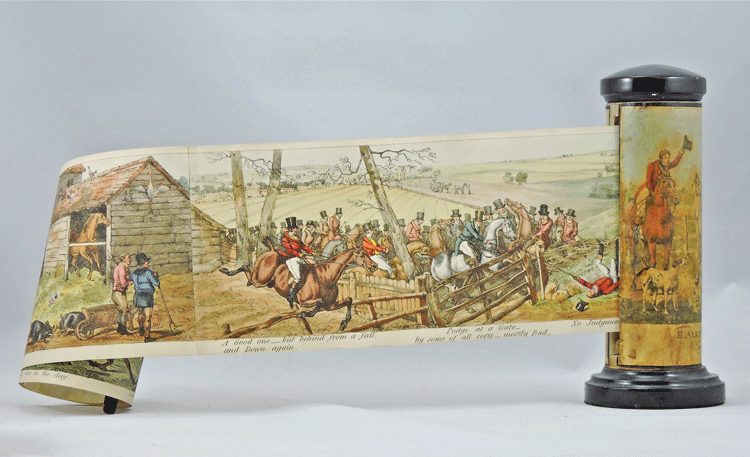Then & There: Scenic Views & Sporting Life

Story and Photos by Richard Hooper
Before there were motion pictures, humans were occasionally inspired to display events in a visually sequential narrative. For example, Trajan’s Column, completed in the year 113 A.D., depicts the Roman emperor’s achievements during the Dacian Wars. Carved into marble, the events span some five years in 155 scenes, with Trajan shown in 58 of them. The timeline begins at the base and spirals around the hundred-plus foot column 23 times. If the frieze were “unrolled” from the column, it would extend to a panorama of 620 feet.
The Bayeux Tapestry (which has recently become known as the Bayeux Embroidery, as that is what it is) shows events leading up to and including the Battle of Hastings in 1066. It is approximately 20 inches tall and
224 feet long.

Strictly speaking, a panorama is any wide view relative to height. But a special category exists that, like the examples above, includes the element of a narrative, told through a sequence of scenes and encompassing a period of time. Monumental examples have continued to be built throughout history, including the towering column located in Place Vendôme in Paris. Completed in 1810, it was constructed to honor Napoleon’s
victory at Austerlitz.
Around the same time as the column honoring Napoleon was being erected, a delightful, smaller and certainly more personal form of narrative panoramas was beginning to rise in popularity, to plateau and last throughout the reign of Queen Victoria. These panoramas were produced on paper with engraved or lithographed scenes that were frequently hand colored. They were usually a few inches in height and printed on long slips of paper that were pasted together to form continuous lengths ranging from a few feet to 15 feet or so. One depicting Queen Victoria’s coronation procession, however, extends to 60 feet. As well as being condensed in size, they were compressed in time and could depict a span of mere hours.

Paper panoramas were either accordion-folded into covers resembling a book or rolled onto a spindle contained in a wooden cylinder. Best of all, when extended for
viewing, there are some that reveal marvelous sporting and equestrian scenes.
It was the age of transportation by horse, and we today do not tend to associate traffic jams, broken down vehicles blocking progress and interference from bad riders and drivers (of carriages and gigs) as part of that age. We would like to believe that it was far simpler and less complicated than our own situation. Yet it is all amply depicted in scenes of spectators going to and from such events as the races or a boxing match. So if “getting there” was not exactly “half the fun,” it was, at the very least, half the experience.

Henry Alken aptly represented the frustrations of travel in his 1819 “Going to Epsom Races.” It also shows the horses before the race and the race itself. From the same year, Isaac Robert Cruikshank’s “Going to a Fight” shows the boxing match as well as the incidents along the road to getting there. As shown in John Leech’s undated panorama, “Coming Home from the Races,” traveling home was probably worse than getting there: too much to drink and eat and everyone leaving at the same time.
Among the most delightful of the sporting panoramas is, of course, fox hunting. One of these, by Henry Alken, is among the first flight. It was published in 1828, with a lengthy title that was typical during the 19th century: “H. Alken’s Panorama of a Fox Hunt – Shewing a large Scope of the Leicestershire, Rutlandshire and Lincolnshire Counties: with all Sorts of Riders; Good, Bad & Indifferent.” It must have been a very long run! The opening scene shows the hunt gathering at the farmyard fixture, and the next is a logjam of the field at the farmyard fence as they attempt to get on with it. It is about 11 feet long and is all action. There was no “getting there” with hacking to the meet.

It is a delightful art form, truly cinematic in its intent.
Even though panoramas were intended to be seen a foot or two at a time, I once tried to extend the full 60 feet of the panorama
of Queen Victoria’s coronation procession in order to see it all at once in its entirety. It got a bit contorted, and confirmed my belief that, contrary to popular opinion, life in the past was more complicated than life today. I mean, all we need to do now is turn on the television. ML


